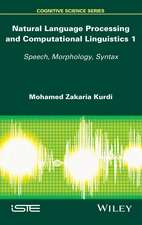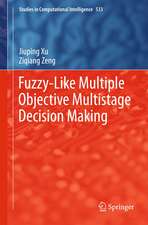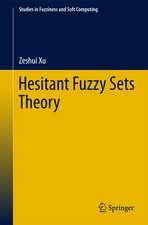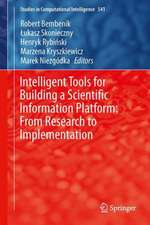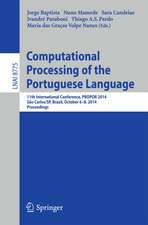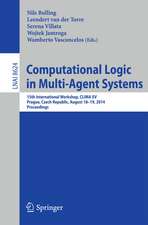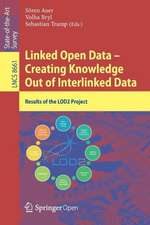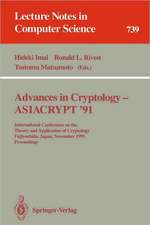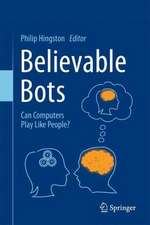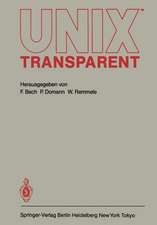Machine Learning: From Theory to Applications: Cooperative Research at Siemens and MIT: Lecture Notes in Computer Science, cartea 661
Editat de Stephen J. Hanson, Werner Remmele, Ronald L. Rivesten Limba Engleză Paperback – 30 mar 1993
Din seria Lecture Notes in Computer Science
- 20%
 Preț: 323.14 lei
Preț: 323.14 lei - 20%
 Preț: 461.32 lei
Preț: 461.32 lei - 20%
 Preț: 460.98 lei
Preț: 460.98 lei - 20%
 Preț: 390.41 lei
Preț: 390.41 lei - 20%
 Preț: 526.98 lei
Preț: 526.98 lei - 15%
 Preț: 388.21 lei
Preț: 388.21 lei - 20%
 Preț: 461.21 lei
Preț: 461.21 lei - 20%
 Preț: 390.08 lei
Preț: 390.08 lei - 20%
 Preț: 496.30 lei
Preț: 496.30 lei - 20%
 Preț: 461.21 lei
Preț: 461.21 lei - 20%
 Preț: 389.45 lei
Preț: 389.45 lei - 15%
 Preț: 461.53 lei
Preț: 461.53 lei - 20%
 Preț: 389.63 lei
Preț: 389.63 lei - 20%
 Preț: 496.68 lei
Preț: 496.68 lei - 20%
 Preț: 461.70 lei
Preț: 461.70 lei - 20%
 Preț: 251.97 lei
Preț: 251.97 lei - 20%
 Preț: 390.86 lei
Preț: 390.86 lei - 20%
 Preț: 532.16 lei
Preț: 532.16 lei - 20%
 Preț: 461.52 lei
Preț: 461.52 lei - 20%
 Preț: 255.72 lei
Preț: 255.72 lei - 20%
 Preț: 498.10 lei
Preț: 498.10 lei - 20%
 Preț: 497.19 lei
Preț: 497.19 lei - 20%
 Preț: 499.02 lei
Preț: 499.02 lei - 20%
 Preț: 389.82 lei
Preț: 389.82 lei - 20%
 Preț: 390.92 lei
Preț: 390.92 lei - 20%
 Preț: 390.86 lei
Preț: 390.86 lei - 20%
 Preț: 390.92 lei
Preț: 390.92 lei - 20%
 Preț: 390.08 lei
Preț: 390.08 lei - 20%
 Preț: 461.45 lei
Preț: 461.45 lei - 20%
 Preț: 392.36 lei
Preț: 392.36 lei - 20%
 Preț: 460.75 lei
Preț: 460.75 lei - 20%
 Preț: 461.32 lei
Preț: 461.32 lei - 20%
 Preț: 389.90 lei
Preț: 389.90 lei - 20%
 Preț: 639.26 lei
Preț: 639.26 lei - 20%
 Preț: 390.66 lei
Preț: 390.66 lei - 20%
 Preț: 391.57 lei
Preț: 391.57 lei - 20%
 Preț: 389.57 lei
Preț: 389.57 lei - 20%
 Preț: 497.97 lei
Preț: 497.97 lei - 20%
 Preț: 462.36 lei
Preț: 462.36 lei - 20%
 Preț: 460.67 lei
Preț: 460.67 lei - 20%
 Preț: 423.95 lei
Preț: 423.95 lei - 5%
 Preț: 515.91 lei
Preț: 515.91 lei - 15%
 Preț: 535.55 lei
Preț: 535.55 lei - 20%
 Preț: 531.90 lei
Preț: 531.90 lei - 20%
 Preț: 403.00 lei
Preț: 403.00 lei - 20%
 Preț: 535.41 lei
Preț: 535.41 lei - 20%
 Preț: 461.25 lei
Preț: 461.25 lei - 20%
 Preț: 498.17 lei
Preț: 498.17 lei - 20%
 Preț: 461.52 lei
Preț: 461.52 lei - 20%
 Preț: 249.77 lei
Preț: 249.77 lei
Preț: 319.60 lei
Preț vechi: 399.50 lei
-20%
Puncte Express: 479
Preț estimativ în valută:
56.57€ • 66.09$ • 49.10£
56.57€ • 66.09$ • 49.10£
Carte tipărită la comandă
Livrare economică 25 februarie-11 martie
Preluare comenzi: 021 569.72.76
Specificații
ISBN-13: 9783540564836
ISBN-10: 3540564837
Pagini: 288
Ilustrații: VIII, 276 p.
Dimensiuni: 155 x 233 x 15 mm
Greutate: 0.41 kg
Ediția:1993
Editura: Springer Berlin, Heidelberg
Colecția Springer
Seria Lecture Notes in Computer Science
Locul publicării:Berlin, Heidelberg, Germany
ISBN-10: 3540564837
Pagini: 288
Ilustrații: VIII, 276 p.
Dimensiuni: 155 x 233 x 15 mm
Greutate: 0.41 kg
Ediția:1993
Editura: Springer Berlin, Heidelberg
Colecția Springer
Seria Lecture Notes in Computer Science
Locul publicării:Berlin, Heidelberg, Germany
Public țintă
ResearchCuprins
Strategic directions in machine learning.- Training a 3-node neural network is NP-complete.- Cryptographic limitations on learning Boolean formulae and finite automata.- Inference of finite automata using homing sequences.- Adaptive search by learning from incomplete explanations of failures.- Learning of rules for fault diagnosis in power supply networks.- Cross references are features.- The schema mechanism.- L-ATMS: A tight integration of EBL and the ATMS.- Massively parallel symbolic induction of protein structure/function relationships.- Task decomposition through competition in a modular connectionist architecture: The what and where vision tasks.- Phoneme discrimination using connectionist networks.- Behavior-based learning to control IR oven heating: Preliminary investigations.- Trellis codes, receptive fields, and fault tolerant, self-repairing neural networks.








